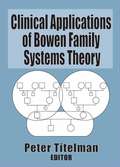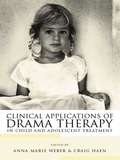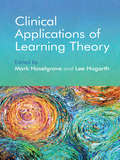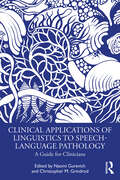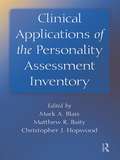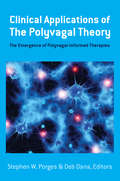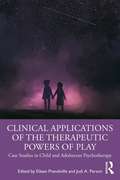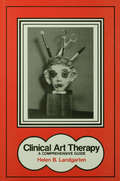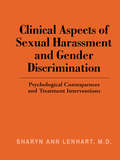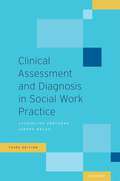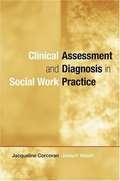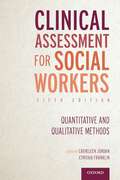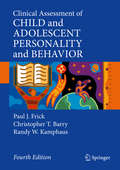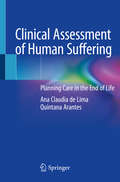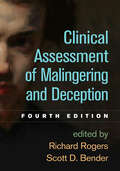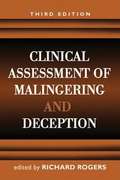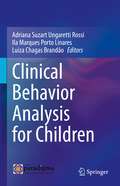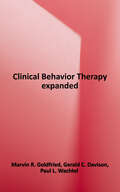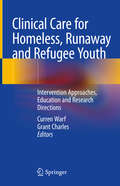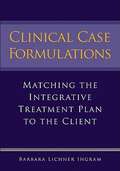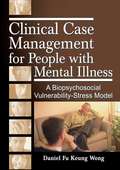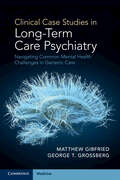- Table View
- List View
Clinical Applications of Bowen Family Systems Theory
by Peter TitelmanOne look inside Clinical Applications of Bowen Family Systems Theory, and you’ll see that your most current clinical dilemmas are not as difficult to solve as you think. You’ll find plenty of information to assist you in treating a vast audience of populations--the elderly, college students, troubled couples, remarried families, and children with severe medical problems. You’ll also find that you’re able to apply the Bowen systems theory to nearly every clinical situation--emotional dysfunction in children, alcoholism, incest, divorce, depression, phobias, and obsessive-compulsive disorders.Clinical Applications of Bowen Family Systems Theory is an ideal companion for family therapists, clinical psychologists, clinical social workers, psychiatrists, psychiatric nurses, and counselors. You’ll find your working comprehension of Murray Bowen’s work will grow, and you’ll become more adept at applying what you read in real-life clinical situations, especially in these related areas: family systems assessment based on the Bowen Theory marital fusion and differentiation bridging emotional cut-off from a former spouse dealing with a child-focused divorce case studies of alcoholism and family systemsClinical Applications of Bowen Family Systems Theory is the first book to collect, illustrate, and walk you through a full application of this highly effective treatment method in any number of clinical settings. Both beginning and experienced therapists will find interesting reading in the history of the theory, and the result will be interested clients who begin to create functional, thriving personal histories for themselves.
Clinical Applications of Drama Therapy in Child and Adolescent Treatment
by Craig Haen Anne Marie WeberAs an emerging psychotherapeutic discipline, drama therapy has been gaining global attention over the last decade for its demonstrated efficacy in the treatment of child and adolescent populations. However, despite this attention and despite the current turbulent state of the world and the increasing population of disturbed and at-risk children, the field of drama therapy has so far lacked a standard text. Weber and Haen’s book fills this need, providing a core text for graduate students and established professionals alike. Clinical Applications of Drama Therapy in Child and Adolescent Treatment is guided by theory, but firmly rooted in practice, providing a survey of the many different possibilities and techniques for incorporating drama therapy within child and adolescent therapy. More than merely a survey of the existing literature on drama therapy, this text represents a true expansion of the field: one which articulates the breadth of possibilities and applications for drama therapy in the larger context of psychotherapy.
Clinical Applications of Learning Theory
by Mark Haselgrove Lee HogarthThis book examines a variety of psychological disorders from the perspective of the psychology of learning. Grounded in the study of classical and instrumental conditioning, learning theory provides an explanatory framework for the way in which humans acquire information, and when applied, how abnormalities in learning may give rise to clinical conditions. This edited volume addresses a wide range of clinically relevant issues in chapters written by international experts in each field. Individual chapters present experimental research into the neuropsychological basis of the acquisition of fears, phobias and clinical aversions, the placebo and nocebo effects, the psychology of drug addiction and relapse following clinical treatment, as well as the role of learning in Tourette’s syndrome, depression and schizophrenia. This book will be particularly useful for undergraduate and postgraduate students of clinical psychology, behavioural neuroscience and those studying the applications of learning theory to clinical or psychiatric research.
Clinical Applications of Linguistics to Speech-Language Pathology: A Guide for Clinicians
by Naomi Gurevich Christopher M. GrindrodClinical Applications of Linguistics to Speech-Language Pathology is a practical guide that provides linguistically grounded approaches to clinical practice. It introduces key linguistic disciplines and discusses how they form a basis for assessment and treatment of individuals with communication differences or disorders. Written by experts in linguistics and communication disorders, each chapter provides clinicians with a foundational understanding of linguistics as it applies to spoken and signed languages and underscores the importance of integrating linguistic theories into clinical decision-making. The book is divided into two parts that focus on the applications of linguistics to speech and language differences and disorders in both children and adults. The chapters cover the full range of linguistic domains including phonetics, phonology, morphology, syntax, semantics, pragmatics, and sociolinguistics. Applications to a wide range of populations including childhood apraxia of speech, aphasia, dysarthria, traumatic brain injury and accent modification clients are also discussed. Many chapters include assessment and treatment resources that can be used by practicing clinicians. This highly accessible and comprehensive book is an indispensable resource for practicing speech-language pathologists and other members of the profession, including instructors with minimal exposure to linguistics. It will also be beneficial for students of Linguistics, Speech and Hearing Sciences, and Audiology and Speech Language Pathology who are seeking practical knowledge of the fields.
Clinical Applications of the Personality Assessment Inventory
by Mark A. Blais Christopher J. Hopwood Matthew R. BaityClinical Applications of the Personality Assessment Inventory demonstrates the broad clinical utility of this modern multi-scale self-report measure of psychological functioning. By bringing together leading experts in psychological assessment from diverse applied settings, the book illustrates the impressive range of current Personality Assessment Inventory (PAI) applications while providing recommendations for expanding the instrument’s research base and clinical use. Many authors also present population specific PAI reference data. In this timely volume, experts from specialized areas of psychological assessment integrate the relevant research with their extensive clinical knowledge of the PAI, making this a valuable text for practitioners, students, and researchers.
Clinical Applications of the Polyvagal Theory: The Emergence Of Polyvagal-informed Therapies (Norton Series on Interpersonal Neurobiology #0)
by Stephen W. Porges Deb A. DanaInnovative clinicians share their experiences integrating Polyvagal Theory into their treatment models. Clinicians who have dedicated their work to bringing the benefits of the Polyvagal Theory to a range of clients have come together to present Polyvagal Theory in a creative and personal way. Chapters on a range of topics from compassionate medical care to optimized therapeutic relationships to clinician's experiences as parents extract from the theory the powerful influence and importance of cases and feelings of safety in the clinical setting. Additionally, there are chapters which: elaborate on the principle of safety in clinical practice with children with abuse histories explain the restorative consequences of movement, rhythm, and dance in promoting social connectedness and resilience in trauma survivors explains how Polyvagal Theory can be used to understand the neurophysiological processes in various therapies discuss dissociative processes and treatments designed to experience bodily feelings of safety and trust examine fear of flying and how using positive memories as an active "bottom up" neuroceptive process may effectively down-regulate defense shed light on the poorly understood experience of grief Through the insights of innovative and benevolent clinicians, whose treatment models are Polyvagal informed, this book provides an accessible way for clinicians to embrace this groundbreaking theory in their own work.
Clinical Applications of the Therapeutic Powers of Play: Case Studies in Child and Adolescent Psychotherapy
by Eileen PrendivilleClinical Applications of the Therapeutic Powers of Play provides a way to link abstract theory with practice-based knowledge and vice versa, navigating the complexities of clinical reasoning associated with age-sensitive, and most often non-verbal psychotherapies. The book invites readers into the world of child psychotherapy and into the play therapy room. It equips them to explore, discover and identify the therapeutic powers of play in action, within traditional and nature-based therapeutic environments. Using embodiment-projective-role, it navigates the developmental stages linking play and the achievement of physical, emotional, and social identity. With captivating stories of hope and repair, the book deconstructs the therapy process to better understand how play facilitates communication, fosters emotional wellness, increases personal strengths, and enhances social relationships. This comprehensive text will help the therapist navigate through the world of child and adolescent psychotherapy and explain the therapeutic powers of play through relevant clinical case studies.
Clinical Art Therapy: A Comprehensive Guide
by Helen B. LandgartenAn integrated guide to the entire range of clinical art therapy. Its scope is immense, covering every age range in a variety of settings from schools and outpatient clinics to psychiatric hospitals and private treatment. Of special value are the extensive case studies and 148 illustrations.
Clinical Aspects of Sexual Harassment and Gender Discrimination: Psychological Consequences and Treatment Interventions
by Sharyn Ann LenhartThis book addresses the psychological impact of sexual harassment and gender discrimination from both a clinical and theoretical perspective, whereas previous literature on the topic has emphasized legal and employment consequences. To start, Lenhart provides a comprehensive summary and integration of existing literature and discusses relevant aspects of the workplace and legal environments. The second portion of the book deals with the psychodynamics of sexual harassment and gender discrimination, placing these violations in proper psychological perspective, along the same lines as rape, battering and other forms of gender-based abuse. The wide spectrum of psychological consequences of discrimination will be discussed and an effective and integrative model for intervention and treatment will be presented.
Clinical Assessment And Diagnosis In Social Work Practice
by Jacqueline Corcoran Joseph WalshIn Clinical Assessment and Diagnosis in Social Work Practice, seasoned practitioner-scholars Jacqueline Corcoran and Joseph Walsh provide an in-depth exploration of fourteen major mental disorders that social workers commonly see in practice, including anxiety disorders, depression, bipolar disorder, and schizophrenia. They skillfully integrate several perspectives in order to help practitioners meet the challenges they will face in client assessment, and present a risk and resilience framework that helps social workers understand environmental influences on the emergence of mental disorders and the strengths that clients already possess. The authors also catalog the latest evidence-based assessment instruments and treatments for each disorder so that social workers can intervene efficiently and effectively, using the best resources available. Students and practitioners alike will appreciate the wealth of case examples,evidence-based assessment instruments, treatment plans, and new social diversity sections that make this an essential guide to the assessment and diagnostic processes in social work practice.
Clinical Assessment and Diagnosis in Social Work Practice
by Jacqueline Corcoran Joseph WalshThis tightly focused textbook will help clinical social workers not only develop competence in the Diagnostic and Statistical Manual (DSM-IV-TR) system of diagnosis, it will also assist them to stay attuned during client assessment to social work values and principles -- a focus on client strengths, concern for the worth and dignity of individuals, appreciation of environmental influences on behavior, and a reliance on evidence-based approaches.
Clinical Assessment for Social Workers: Quantitative And Qualitative Methods
by Catheleen Jordan Cynthia FranklinClinical Assessment for Social Workers provides a wide range of standardized assessment tools, derived from different perspectives, to give readers greater flexibility in information gathering and intervention planning. Incorporating both quantitative and qualitative methods, the authors encourage readers to approach assessment as both an art and a science. They advocate for discovering the balance between scientific, evidence-based approaches and the development of personal practice wisdom.
Clinical Assessment of Child and Adolescent Personality and Behavior
by Paul J. Frick Randy W. Kamphaus Christopher T. BarryPsychologists offer an increasing variety of services to the public. Among these services, psychological assessment of personality and behavior continues to be a central activity. One main reason is that other mental health professionals often do not possess a high level of competence in this area. And when dealing with children and adolescents, psychological assessment seems to take on an even greater role. Therefore, it follows that comprehensive graduate-level instruction in assessment should be a high priority for educators of psychologists who will work with these youth. This textbook is organized into three sections, consistent with the authors' approach to teaching. Part I provides students with the psychological knowledge base necessary for modern assessment practice, including historical perspectives, measurement science, child psychopathology, ethical, legal, and cultural issues, and the basics of beginning the assessment process. Part II gives students a broad review of the specific assessment methods used by psychologists, accompanied by specific advice regarding the usage and strengths and weaknesses of each method. In Part III, we help students perform some of the most sophisticated of assessment practices: integrating and communicating assessment results and infusing assessment practice with knowledge of child development and psychopathology to assess some of the most common types of behavioral and emotional disorders in youth. A text focusing on assessment practices must be updated every four to six years to keep pace with advances in test development. For example, several of the major tests reviewed in the text, such as the Behavioral Assessment System for Children and the Child Behavior Checklist, have undergone major revisions since the publication of the last edition making the current content outdated. Further, another major test, the Conners' Rating Scales, is undergoing substantial revisions that should be completed before publication of the next edition. Finally, the evidence for the validity of the tests and the recommendations for their appropriate use evolve as research accumulates and requires frequent updating to remain current. For example, there was a special issue of the Journal of Clinical Child and Adolescent Psychology published focusing on evidenced-based assessment of the major forms of childhood psychopathology that will need to be integrated into the chapters in Part 3. This latter point reflects an important trend in the field that should influence the marketing of the book. That is, there are several initiatives being started in all of the major areas of applied psychology (e.g., school, clinical, and counseling) to promote evidenced-based assessment practices. These initiatives have all emphasized the need to enhance the training of graduate students in this approach to assessment. This has been the orientation of this textbook from its first edition: that is, Clinical Assessment of Child and Adolescent Personality and Behavior has focused on using research to guide all recommendations for practice. The ability of the textbook to meet this training need should be an important focus of marketing the book to training programs across all areas of applied psychology.
Clinical Assessment of Child and Adolescent Personality and Behavior
by Paul J. Frick Randy W. Kamphaus Christopher T. BarryThe fourth edition of this textbook offers a scientific and practical context within which to understand and conduct clinical assessments of children’s and adolescent’s personality and behavior. The new edition ensures that the content is relevant to diagnostic criteria for major forms of child and adolescent psychopathology in the 5th edition of the Diagnostic and Statistical Manual of Mental Disorders (DSM-5). It provides updated information on specific tests and discusses advances in research that have occurred since the last edition that are relevant for assessing the most common forms of psychopathology shown by children and adolescents. The volume is unique in providing both the scientific and ethical basis to guide psychological testing, as well as providing practical advice for using specific tests and assessing specific forms of psychopathology. This new edition:Highlights how current trends in psychological classification, such as the DSM-5 and the Research Domain Criteria, should influence the clinical assessment of children and adolescents.Provides updates to professional standards that should guide test users.Discusses practical considerations in planning and conducting clinical assessments. Evaluates the most recent editions of common tests used in the clinical assessment of child and adolescent personality and behavior.Provides an overview of how to screen for early signs of emotional and behavioral risk for mental problems in children and adolescents. Discusses practical methods for integrating assessment information collecting as part of a clinical assessment.Uses current research to guide clinical assessments of children with Attention-deficit/Hyperactivity Disorder, conduct problems, depression, anxiety, and autism spectrum disorder. Clinical Assessment of Child and Adolescent Personality and Behavior is a valuable updated resource for graduate students as well as veteran and beginning clinicians across disciplines, including school, clinical child, developmental, and educational psychology; psychiatry; counseling; and social work; as well as related disciplines that provide mental health and educational services to children and adolescents.
Clinical Assessment of Human Suffering: Planning Care in the End of Life
by Ana Claudia ArantesThis book is addressed to physicians and other health professionals involved in the assessment and care planning of patients at the end of life. It brings a unique and humanistic view on the challenges of good practice in palliative care. Concepts and definitions, resources and therapeutic alternatives, as well as symptoms of distress in the physical, emotional, family, social and spiritual dimensions are discussed in a clear and practical way, demystifying and dissolving the barriers of this approach.
Clinical Assessment of Malingering and Deception, Fourth Edition
by Richard Rogers Scott D. BenderWidely used by practitioners, researchers, and students--and now thoroughly revised with 70% new material--this is the most authoritative, comprehensive book on malingering and other response styles. Leading experts translate state-of-the-art research into clear, usable strategies for detecting intentional distortions in a wide range of psychological and psychiatric evaluation contexts, including forensic settings. The book examines dissimulation across multiple domains: mental disorders, cognitive impairments, and medical complaints. It describes and critically evaluates evidence-based applications of multiscale inventories, other psychological measures, and specialized methods. Applications are discussed for specific populations, such as sex offenders, children and adolescents, and law enforcement personnel. New to This Edition *Many new authors and topics. *Thoroughly updated with current data, research methods, and assessment strategies. *Chapters on neuropsychological models, culturally competent assessments, psychopathy, and conversion disorder. *Chapters on psychological testing in child custody cases and in personnel selection/hiring.
Clinical Assessment of Malingering and Deception, Third Edition
by Richard RogersWidely regarded as the standard reference in the field, this book provides essential tools for understanding and assessing malingering and other response styles in forensic and clinical contexts. An integrating theme is the systematic application of detection strategies as conceptually grounded, empirically validated methods that bridge different measures and populations. Special topics include considerations in working with children and youth. From leading practitioners and researchers, the volume reviews the state of the science and offers best-practice guidelines for maximizing the accuracy of psychological and psychiatric evaluations.
Clinical Behavior Analysis for Children
by Adriana Suzart Ungaretti Rossi Ila Marques Porto Linares Luiza Chagas BrandãoThis book is a guide for child psychotherapists interested in applying clinical behavioral analysis to their work and for clinical behavior analysts working with children. In the literature of behavior analysis, a considerable number of publications present clinical strategies to more effectively conduct therapeutic interventions with adults and adolescents, but there is still a lack of publications that address practical aspects of the work of the child behavior analytic therapist. This volume aims do fill this void by bringing together chapters written by therapists who share their views on theoretical and practical aspects of child care and describe the stages and challenges of the psychotherapy process with clients of up to 12 years of age. Chapters in this volume provide an overview of the specific knowledge and techniques clinical behavior analysts need to master to work with children, such as theories of child development from the perspective of behavior analysis; biological influences on the development of child behavior; clinical assessment and definition of therapeutic goals in the work with children; how to include functional play in clinical settings; and how to involve parents and the school in the therapeutic process. Additionally, specific chapters focus on the application of third wave behavioral therapies, such as Acceptance and Commitment Therapy and Functional Analytic Psychotherapy, to the clinical work with children. Clinical Behavior Analysis for Children will be a valuable resource for psychotherapists and clinical psychology students looking for a guide to understand the specificities of clinical behavior analysis applied to child psychotherapy.
Clinical Behavior Therapy, Expanded Edition
by Gerald C. Davison Marvin R. GoldfriedCritical Acclaim for Clinical Behavior Therapy "This book will be helpful not only to those who regard this [cognitive-behavior therapy] as their primary orientation, but to anyone who wants to be a complete therapist." --Allen Frances, MD Duke University Medical Center "This classic text. was a distinct favorite among the students enrolled in my clinical assessment and treatment courses. I hope the updated edition will be read by graduate students in clinical and counseling psychology, social workers, and all mental health professionals who wish to be truly effective therapists." --Arnold A. Lazarus, PhD Rutgers University ". particularly innovative and impressive. Their lucid description of cognitive variables. broadens the range of interventions available to the behavioral practitioner."-Sheldon Rose, PhD, University of Wisconsin School of Social Work "A classic--updated. I recommend it not only for behavior therapists but for any clinical practitioner of any profession who is looking for procedures that work." --Joel Fischer, DSW University of Hawaii at Manoa
Clinical Care for Homeless, Runaway and Refugee Youth: Intervention Approaches, Education and Research Directions
by Curren Warf Grant CharlesAdolescent homelessness is a growing problem that results in a variety of health challenges. This text is a practical resource designed to promote effective interdisciplinary health and social care interventions targeting adolescents who are homeless or at risk for homelessness. It is based on extensive interdisciplinary experience, reviews of pertinent research and insights and contributions of leading professionals who are directly involved in the care of these young people.Divided into four main sections, Section 1: (Chapters 1-7) section one is a review of the structure and professional involvement of program models targeting youth experiencing or at risk for homelessness to encourage broader understanding and utilization of principles and practices underlying effective programs and identify replicable components. Section 2: (Chapters 8-16) Section two is clinically focused with recommendations for working with adolescents and youth experiencing homelessness and interventions for common and significant medical and mental health conditions, and substance use disorders. Section 3: (Chapter 17) Reviews international agreements regarding stabilization and care of refugee youth and families, description of experiences of refugee children and youth in developed countries, and an outline of conditions from which refugee youth and families have left. Section 4: (Chapters 18 and 19) Engagement of homeless youth in research and future research directions to address needs of youth experiencing homelessness.Written by experts from a variety of disciplines, Clinical Care for Homeless, Runaway and Refugee Youth is a first of its kind text for physicians, social workers, public health workers and any other individual that works directly with these vulnerable populations.
Clinical Case Formulations
by Ingram Barbara LichnerA step-by-step model for individualized case conceptualization This innovative new guide addresses the essential question facing every therapist with a new client: How do I create a treatment plan that is the best match for my client? This unique resource provides a systematic method to integrate ideas, skills, and techniques from different theoretical approaches, empirical research, and clinical experience to create a case formulation that is tailor-made for the client. Clinical Case Formulations is divided into three parts: * Getting Started--provides an overview that sets forth a framework for case formulation and data gathering. * 28 Core Clinical Hypotheses--offers a meta-framework embracing all theories, orientations, and mental health intervention models and presents clinical hypotheses within seven categories: Biological Hypotheses; Crisis, Stressful Situations, and Transitions; Behavioral and Learning Models; Cognitive Models; Existential and Spiritual Models; Psychodynamic Models; and Social, Cultural, and Environmental Factors. These hypotheses are combined and integrated to develop a coherent conceptualization of the client's problems. * Steps to a Complete Case Formulation--provides a structured framework known as the Problem-Oriented Method (POM). Using the POM and integrating multiple hypotheses, the therapist learns how to think intelligently, critically, and creatively in order to develop a tailor-made treatment plan. A list of thirty-three standards for evaluating the application of this method is provided. With this practical guide you will learn to conceptualize your clients' needs in ways that lead to effective treatment plans while finding the tools for troubleshooting when interventions fail to produce expected benefits.
Clinical Case Formulations
by Barbara Lichner IngramA step-by-step model for individualized case conceptualization Fully revised and updated, the second edition of Clinical Case Formulations provides step-by-step tools and insightful guidance for moving from first contact with a client to the development of an effective, personalized treatment plan. Addressing the essential question every therapist faces-How do I create a treatment plan that is the best match for my client?-this unique resource provides a systematic and thoughtful method for integrating ideas, skills, and techniques from different theoretical approaches. It combines empirical research and clinical experience to create a case formulation that is tailor-made for the client. This comprehensive resource offers two tools to guide case formulations: a problem-oriented framework, with a list of 28 standards for evaluating its application, and a set of 30 core clinical hypotheses derived from the knowledge bases of psychology, psychiatry, counseling, and social work professions. The new edition includes: Hypotheses on Emotional Focus, Trauma, and Metacognitive Perspective More detailed attention given to empirically supported therapies such as Dialectical Behavior Therapy (DBT) and Acceptance and Commitment Therapy (ACT) Discussion on the importance of bringing cultural competence to case formulation tasks with every client Skill-building activities throughout the text Offering a thorough framework to help clients experience effective clinical service, practitioners will learn to conceptualize clients' needs in ways that lead to strong and individualized treatment plans, as well as advice and guidance on what to do when selected interventions fail to produce the expected benefits.
Clinical Case Management for People with Mental Illness: A Biopsychosocial Vulnerability-Stress Model
by Daniel Fu WongA unique-and effective-approach to mental health practiceClinical Case Management for People with Mental Illness combines theory, practice, and plenty of clinical examples to introduce a unique approach to case management that&’s based on a biopsychosocial vulnerability-stress model. This practice-oriented handbook stresses the dynamic interplay among biological, psychological, social, and environmental factors that influences the development-and severity-of a person&’s mental illness. Filled with case examples to illustrate the assessment and intervention process, the book is an essential resource for working with people who suffer from depression, anxiety disorders, schizophrenia, and personality disorders.Author Daniel Fu Keung Wong draws on his experiences as an educator, cognitive therapist, mental health worker, and case manager working in Asia and Australia to explore the concepts and contexts of clinical case management for individuals suffering from mild and chronic mental illness. He guides you through the creative use of various therapeutic approaches that emphasize different aspects of a person&’s condition that can influence the cause and course of mental illness. Clinical Case Management for People with Mental Illness examines a range of important topics, including the roles and functions of mental health workers, relapse prevention, assessment and clinical intervention, psychiatric crisis management, and working with families. In addition, the book includes checklists, worksheets, activity charts, and three helpful appendices. Clinical Case Management for People with Mental Illness examines: models of assessment microskills in assessment areas of assessment and intervention understanding the roles and psychological reactions of family members assessing and working with individuals with suicidal risk or aggressive behaviors and much more!Clinical Case Management for People with Mental Illness is an essential resource for mental health professionals, including psychologists, occupational therapists, mental health social workers, nurses, counselors, and family social workers.
Clinical Case Studies in Long-Term Care Psychiatry: Navigating Common Mental Health Challenges in Geriatric Care
by Matthew Gibfried George T. GrossbergThe mental healthcare of older adults can lead to age specific challenges, however, many healthcare settings have limited access to expert geriatric psychiatric consultation. This compelling book provides a comprehensive compilation of real-life cases involving the psychiatric care of older adults in the long-term care setting. Providing practical guidance for healthcare professionals who work regularly with older adults, the chapters cover key topics such as neurocognitive disorders, mood disorders, anxiety disorders, psychotic disorders, end-of-life mental health care, and sexuality issues in older adults. Offering all the information necessary for the diagnosis and formulation of treatment plans for a wide variety of psychiatric presentations, the book covers pharmacologic and non-pharmacologic options for each disorder to assist healthcare professionals in providing well-rounded care. For all those involved in the prevention, assessment, diagnosis, and management of neuropsychiatric disorders in long-term care populations.
Clinical Casebook of Couple Therapy
by Alan GurmanVividly depicting the process of therapy, this instructive casebook presents in-depth illustrations of treatment based on the most important couple therapy models. An array of leading clinicians offer a window onto how they work with clients grappling with mild and more serious clinical concerns, including conflicts surrounding intimacy, sex, power, and communication; parenting issues; and mental illness. Featuring couples of varying ages, cultural backgrounds, and sexual orientations, the cases shed light on both what works and what doesn't work when treating intimate partners. Each candid case presentation includes engaging comments and discussion questions from the editor.
